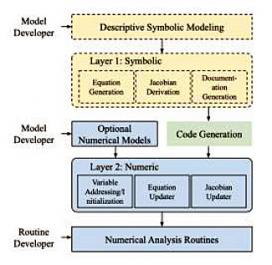Large-Scale Test Bed (LTB) Yields Increasing Capability for Stable, Secure Power Grid Operation
A Large-Scale System Testbed (LTB) established at the University of Tennessee-Knoxville (UTK) represents large power grids of the future, such as that of North America, at several resolution levels for both evaluation of new technologies and to drive research efforts. In 2020, researchers used the LTB to develop and apply a communication network arrangement for ultra-wide-area power system data streaming, which can also be used for assessing cyber-physical security. The LTB and these research efforts are supported by the Center for Ultra-Wide-Area Resilient Electric Energy Transmission Networks (CURENT), a National Science Foundation (NSF) Engineering Research Center (ERC) supported by NSF and the U.S. Department of Energy and headquartered at UTK.
The CURENT LTB enables a comprehensive evaluation of the impact of changes and new technologies on the operation of future power grids. Testbed models include different scenarios of generation mix and operation, wide-area measurements, new actuation technologies, and new control strategies. This project involved tailoring open-source software packages for power system modeling and transient simulation (computing a circuit's response as a function of time) for specific studies. The CURENT-UTK researchers developed a hybrid software framework that combines symbolic and numeric problem-solving methods, enabling them to easily develop complex power system simulation models. They were able to test and verify their approach and results using commercial software in test systems that are part of the CURENT LTB.
With the recent proliferation of open-source packages for computing, power system differential-algebraic equation (DAE) modeling and simulation are being revisited to reduce the programming efforts. Existing open-source tools require manual efforts to develop code for numerical equations, sparse Jacobians, and discontinuous components. As outlined in the Figure below, this project involved designing a two-layer library that brings together the advantages of symbolic and numeric approaches. The symbolic layer is case-independent and handles descriptive modeling, symbolic processing, code generation, and automated documentation. The numeric layer organizes the generated code for case-dependent initialization, equation update, and Jacobian update. The library was verified for power flow calculation and time-domain simulation, and the computation time analyzed.
The CURENT LTB is a closed-loop software platform that continuously simulates the dynamics, communication, and control of modern power grids with high penetration of renewable energy. Since 2019, the LTB has received four licensed users (including two pending) and also played a critical role for research demonstrations to assist with 5 successes with funded proposals led by external users totaling $3.8 million. In 2020, CURENT’s LTB was selected as a recipient of the R&D 100 Awards, a top honor for revolutionary ideas and products each year in science and technology.



